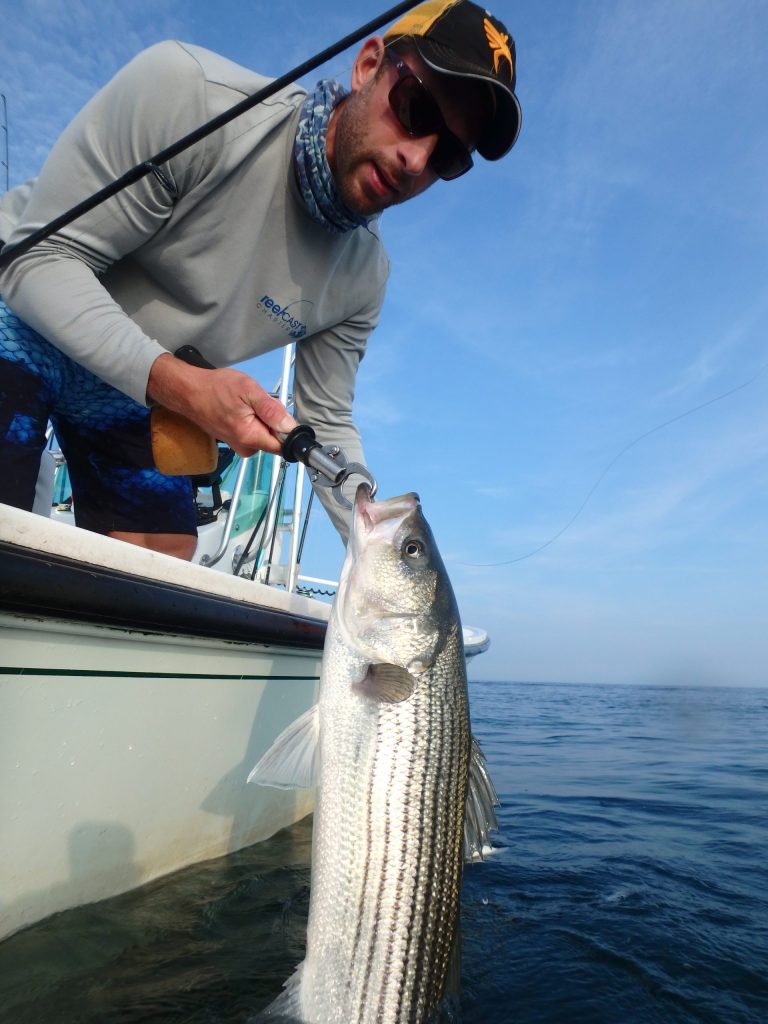
Here we are, at the beginning of another season of saltwater fishing in Southern New England. This is a wonderful time of the year for me as there is so much promise, so much hope, and so much excitement about the months that lie ahead. Seasons are opening, migrating fish are returning and the water is warming by the day. So, with a clean slate ahead, let’s see what the fishing gods might have in store for us as we set out for a day on the water…
My boat fishing season usually begins each year with a few blackfish/tautog trips in my home waters of Connecticut. Unfortunately, by the time you read this the spring season in both New York and the Nutmeg state will most likely have closed as of April 30. However, so long as you remain in state waters for both your port of call and your entire stay at sea, the spring season runs from April 1 through May 31 in Rhode Island. Blackfish are both challenging and simple to catch as most any reef, rockpile or hard structure holds at least a small population of tog, and little more is needed than some crabs for bait and a hook with sinker heavy enough to tend bottom.

Sticking with the bottom fishing theme, the month of May also marks a fantastic opportunity to fill your cooler with tasty scup/porgy. The season runs year-round, and much like blackfish, catching them is simple. Squid or pieces of clam tongue roughly the size of your thumbnail fished on a 2-hook rig with enough lead to tend bottom, fished over some sort of hard structure, is sure to put you onto a bite. If you have the means to run across the Sound to Long Island, Peconic Bay is one of the premier locations throughout the month for hubcap-sized porgies, but they can also be found closer to home along much of the Rhode Island and Connecticut coast. You can usually follow the fleet here and fish around other boats as not too many of the hot spots are secret these days. I’d suggest water depths in the range of 20 to 50-or-so feet if you’re looking for your own piece of structure. Expect to run into some varied bycatch on the porgy grounds in the form of fluke, black sea bass, bluefish, striped bass, sea robin and even the occasional weakfish (just be sure to check the local regulations if you plan to harvest fluke or sea bass as they open at varying times in each state.)
I’d be remiss if I didn’t specifically touch upon fluke (summer flounder) for at least a moment here, as the fishing kicks off this month as well. While not as many anglers target them in May as do in the summer months, fluke are currently migrating inshore right now from their deep, winter haunts, so expect to find them in the deep waters south of Block Island at the beginning of the month. By month’s end, however, fluke—and oftentimes some large ones—can be caught shallow, especially if we have an early warm spell. While traditional bait rigs consisting of squid and spearing produce plenty of fluke to this day, the trend in recent years has been to target fluke with lighter bucktail jigs tipped with either squid, Berkley Gulp! or Z-Man Doormatadorz. This is especially effective in shallow waters or out deep when fluke are feeding on small, young-of-the-year squid and sand eels.
If you do not have access to a boat of your own, or if it isn’t in the water just yet, there are plenty of options to target bottom fish in the form of both private charters and larger party boats. In Rhode Island, there is a small fleet of party boats that sail out of Point Judith, and almost every marina in Rhody is home to at least a handful of smaller, 6-pack boats that can get you to the fishing grounds. In Connecticut, party boats can be found sailing out of the Thames River, Niantic River, Clinton Harbor, and several points west. Also, just like in Rhode Island, there is no shortage of private charter options all along the Connecticut coast.
Last, but certainly not least, striped bass return to local waters in May. Now in reality there are wintering-over populations of stripers in pretty much every coastal state of the mid-Atlantic and New England so technically they can be caught 12 months per year, but the 5th month marks the annual northward migration of those fish who decided to head south for the winter and partake in the annual spawning ritual. Finding spring striped bass is simple as they quite predictably follow migrating bait. Many large rivers of southern New England play host to spawning runs of American shad and river herring, and striped bass seek them out. Concentrate on the lower stretches of rivers such as the Housatonic, Connecticut, and the Thames with topwater lures (the Doc Spook is a great option) as well as soft plastics like the Slug-Go, Fin-S Fish or any other 5- to 9-inch option that looks like a long, slender baitfish. Bunker (also referred to as pogy or menhaden depending on where you hail from) have also become a prime spring bait, and livelining these large, energy-packed baitfish often produces the biggest stripers of the spring. Just keep in mind that any time you target striped bass with bait—live or dead—new regulations require the use of inline, non-offset circle hooks. There is also a slot limit now in place if you choose to harvest a striped bass for the table with a 1-fish bag limit per angler and a slot of 28-35 inches meaning only fish that fall within this range may be kept; any fish that falls above or below the slot must be returned to the water as quickly as possible and without inflicting any undue harm.
Be sure to check back next month as stripers take top billing, fluke fishing should be improving, and we begin to look offshore in search of those first tuna schools of the year.
